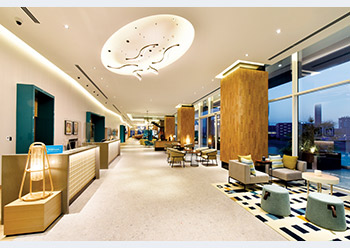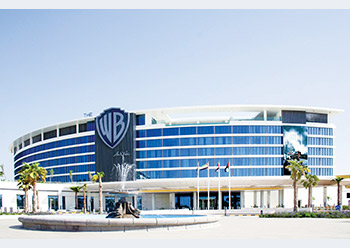
 Guests will enter the Desert Rock resort through a hidden valley nestled between the mountains.
Guests will enter the Desert Rock resort through a hidden valley nestled between the mountains.
The Red Sea Project, the world’s most ambitious regenerative tourism project, is setting the stage for unique experiences for visitors looking to explore its pristine islands, sweeping sand dunes and mountain canyons in the remote virgin terrain of northwestern Saudi Arabia. In line with this ambition, the destination is expected to comprise 50 resorts, offering up to 8,000 hotel rooms alongside a host of leisure facilities when it is fully completed in 2030.
Among such unique experiences, the project’s developer The Red Sea Development Company (TRSDC) last month unveiled designs for its spectacular Desert Rock mountain resort, which will integrate architecture with nature as it will be built into the stunning Saudi mountain landscape. This follows the earlier launch of the Coral Bloom resort project on Shurayrah island in the Red Sea.
 |
|
Guests will enter the Desert Rock resort through a hidden valley nestled between the mountains. |
Created by the world-class architectural design firm Oppenheim Architecture, Desert Rock is designed to protect and preserve the environment and built into the beautiful wadi vistas in the west of the country, allowing guests to connect with the nature and local culture of the region.
Site preparation works have commenced, and construction on the project began in July this year.
“We wanted to create a destination that allows guests to experience Saudi Arabia’s untouched beauty. Desert Rock will provide guests with uninterrupted spectacular views while preserving the natural landscape for future generations to enjoy,” says John Pagano, CEO at TRSDC.
“We have drawn inspiration from the surrounding environment, while providing unparalleled luxury, allowing guests to connect with nature and create memorable experiences,” he adds.
Guests will enter the resort through a hidden valley nestled between the mountains. From there, they will find 48 villas and 12 hotel rooms within the mountain – a total of 60 keys – located amongst the vista, with architecture fully integrated into the rock to preserve its striking silhouette, a tribute to Oppenheim Architecture’s philosophy to build with the land, not on the land.
A range of accommodation units will be available, from ground-level dwellings to crevice hotel suites midway up the mountain, and a select number of excavated rooms within the rock massif itself.
To provide undisturbed views across the landscape, most roads leading into the resort will be pushed to the edge of the main wadi and hidden behind landscape mounds. This will also minimise sound and light pollution, allowing guests to fully absorb the dramatic desert landscape.
The resort will feature state-of-the-art facilities, including a world-class spa and fitness centre, remote destination dining areas as well as a feature lagoon oasis. Guests will be able to hike, use dune buggies, and star gaze as part of the site-wide activities programme.
Commenting on the status of work on the project, Ian Williamson, Chief Project Delivery Officer at TRSDC, tells Gulf Construction: “Enabling works commenced in July this year and remain on track for this resort to complete as part of Phase One development.”
SUSTAINABLY CONSTRUCTED
 |
|
The 60-key Desert Rock will be built into the stunning Saudi mountain landscape. |
As part of TRSDC’s commitment to regenerative tourism, Desert Rock will be designed to achieve the highest Leadership in Energy and Environmental Design (LEED) certification level.
“TRSDC and our partners are investigating in the most innovative and sustainable approaches to delivering this ground-breaking resort, which is elevated 175-m-plus above sea level with dramatic topography, and villa elevations vary from 180-m-plus to 280-m-plus above sea level,” says Williamson.
“This includes elements such as power and water supply, drainage networks and the wider delivery of our regenerative approach to development. The resort will be powered by 100 per cent renewable energy, as will the wider destination, with no connection to the national grid,” he adds.
The architecture has been designed to reduce energy consumption and regenerate native flora. Water retention and distribution systems will be used throughout the site, with harvested rainwater used to create a more green, flourishing wadi.
Alongside this, materials excavated from the site will be used to create the infrastructure. Stone will be used for interior and exterior walls and floors, while ground stone and existing sand will be used for concrete aggregate – which is the main building material for all the architecture.
Chad Oppenheim, Founder of Oppenheim Architecture, says: “Desert Rock is one of the most dramatic desert landscapes in the world, which is why we wanted to use the architecture as a way to honour and respect it. By utilising natural materials and integrating the resort into the rock, guests can connect physically with the destination and experience Saudi Arabia’s stunning, natural beauty.”
The project also aims to maintain the ancient history of the site by hiring members of the local community to act as stewards of the land and provide educational tours for visitors about the local history of the area.
CORAL BLOOM
 |
|
Coral Bloom hotels are designed to give the impression that they have washed up on the beaches. |
Designed to protect, blend with and enhance the pristine natural environment at The Red Sea Project’s main hub island Shurayrah, Coral Bloom has been created by architectural firm Foster + Partners which was appointed to design 11 hotels on island.
The plan is designed to avoid disruption of the Shurayrah’s mangroves and other habitats, while providing natural defences from erosion, and creating new habitats through landscaping to enhance the island’s natural state. It will see new beaches created on the dolphin-shaped island along with a new lagoon. These enhancements will contribute to raising the level of the land, providing a defensive layer from the global threat of rising sea levels.
Shurayrah is one of 92 islands in the project’s archipelago, which is home to the world’s fourth largest barrier reef system, untouched corals and a significant number of endangered species, according to TRSDC.
The island’s natural landscape will be used to dramatic effect with all hotels and villas nestled within the landscape. The absence of high-rise buildings will ensure the spectacular vistas remain uninhibited, while creating a sense of mystery for guests as the island slowly reveals itself, it adds.
The hotel designs have also been responsive to the changing world and traveller demands over the past two years. There will be no internal corridors for example, in response to a growing demand for space and seclusion following the coronavirus pandemic. The resorts themselves will be created using lightweight materials with a low thermal mass and manufactured offsite, meaning more energy-efficient construction and less impact on the environment, according to TRSDC.
Gerard Evenden, Head of Studio at Foster + Partners, says: “Our vision for Shurayrah is inspired by the island’s natural state, with the hotels designed to give the impression that they have washed up on the beaches and nestled among the dunes almost like driftwood.
“The materials we use and the low impact they have ensures that the pristine environment is protected, while the additions we make to the island serve to enhance what is already there – hence the name, Coral Bloom.”
PROJECT OVERVIEW
 |
|
Coral Bloom will comprise 11 hotels on Shurayrah island. |
The Red Sea Project has already passed significant milestones on the destination and work is on track to welcome the first guests by the end of 2022, when the first hotels will open. Phase One, which includes 16 hotels in total, will complete by the end of 2023.
Activity on the first phase of development is well under way with over 600 contracts signed to date, worth over SR17 billion ($4.5 billion). A 100-hectare landscape nursery, which will provide more than 15 million plants for the destination, is now fully operational. There are more than 8,000 workers currently on-site and 80 km of new roads are now complete, including the new airport road, to better connect the destination. The Construction Village, set to house 10,000 workers, is now open and development is progressing well at the Coastal Village, which will be home to around 14,000 people who will eventually work at the destination.
Upon completion in 2030, the destination will comprise 50 resorts and more than 1,000 residential properties across 22 islands and six inland sites. The destination will also include luxury marinas, golf courses, entertainment, leisure facilities and an international airport. The project is being developed over 28,000 km of pristine lands and waters along Saudi Arabia’s west coast.
HOTEL MANAGEMENT DEALS SIGNED
 |
The St Regis hotel to come up at the project. |
THE RED Sea Development Company (TRSDC) announced late last month that it has signed nine hotel management agreements with international hotel brands to operate more than 1,700 of the 3,000 hotel rooms that are planned be ready under Phase One.
The brands that are set to operate nine of the 16 properties currently under development in the first phase include: Edition Hotels and St Regis Hotels & Resorts, part of Marriott International; Fairmont Hotel & Resorts, Raffles Hotels & Resorts and SLS Hotels & Residences, part of global hospitality group Accor; Grand Hyatt, part of Hyatt Hotels Corporation; InterContinental Hotels & Resorts and Six Senses, part of IHG Hotels & Resorts; and Jumeirah Hotels & Resorts, a global luxury hospitality company.
“We are proud to unveil our collection of unique and diverse hospitality brands that cater to this growing market and underpin our commitment to creating a world-leading barefoot luxury destination which will soon serve as a gateway to one of the last undiscovered places on the planet,” says John Pagano, CEO at TRSDC.
“Most importantly, such partnerships with globally recognised and respected brands signifies the growing confidence in our business, our flagship destination and in Saudi Arabia as a tourism destination.” he adds.








.jpg)




.jpg)




























.jpg)




































